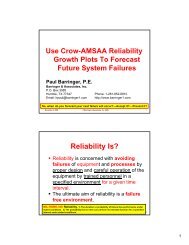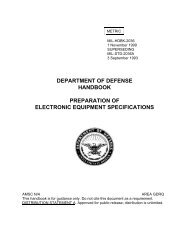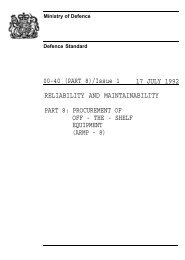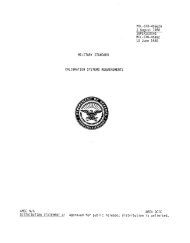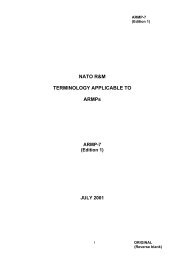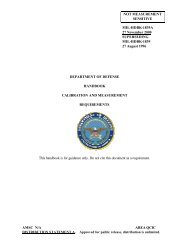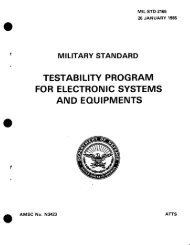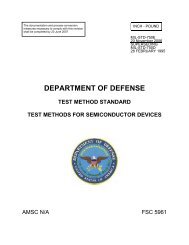MIL-STD-1629-RevA - Barringer and Associates, Inc.
MIL-STD-1629-RevA - Barringer and Associates, Inc.
MIL-STD-1629-RevA - Barringer and Associates, Inc.
You also want an ePaper? Increase the reach of your titles
YUMPU automatically turns print PDFs into web optimized ePapers that Google loves.
MT7,-STW <strong>1629</strong>AFOREWORDIThe~failure mode, effects, <strong>and</strong> criticality analysis (FMECA) is an essentialfunction in design,from concept through development. To be effective,the FMEcA must be iterative to correspond Wit}l ~he nature of the designprocess itself. The extent of effort <strong>and</strong> sophistication of approachused in the F~CA will be dependent upon the nature <strong>and</strong> requirements ofthe individual program. This makes it necessary to tailor the requirementsfor an FMECA to each individual program. Tailoring requires that,regardless of the degree of sophistication, the FMECA must contributemeaningfully to program decision. A properly performed F’MECA is invaluableto those who are responsible for making program decisions regarding thefeasibility <strong>and</strong> adequacy of a design approach.The usefulness of the FMECA as a design tool <strong>and</strong> in the decision makingprocess is dependent upon the effectiveness with which problem informationis communicated for early design attention. Probably the greatestcriticism of the ~~A has been its limited use in improving designs.The chief causes for this have been untimeliness <strong>and</strong> the isolated performanceof the F~CA without adequate inputs tO the design process. Timelinessis perhaps the most important factor in differentiating between effective<strong>and</strong> ineffective implementation of the FITECA. While the objective of anFMECA is to identify all modes of failul-e ~ithin a system design, itsfirst purpose is the early identification of all catastrophic <strong>and</strong> criticalfailure possibilities so they can be eliminated or minimized throughdesign correction at tt~eearliest possible time. Therefore, the FMECAshould be initiated as soon as preliminary design information is availableat the higher system levels <strong>and</strong> extended to the lower levels as moreinformation becomes available on the items in question.Although the FMECA is an essential reliability task, it also providesinformation for other purposes. The use of the FMECA is called for inmaintainability, safety analysis, survivabili~y <strong>and</strong> vulnerability,logistics support analysis, n~ai~~tenarlceplan anaiysis, <strong>and</strong> for failuredetection <strong>and</strong> isolation subsystem desi~n. This coincident use musL be aconsideration in planning the F~CA effort LO prevent the proliferationOf requirements <strong>and</strong> t}leduplication of efforts within the same contractualprogram.a.iii— .. .——. --.—.—-——--—



